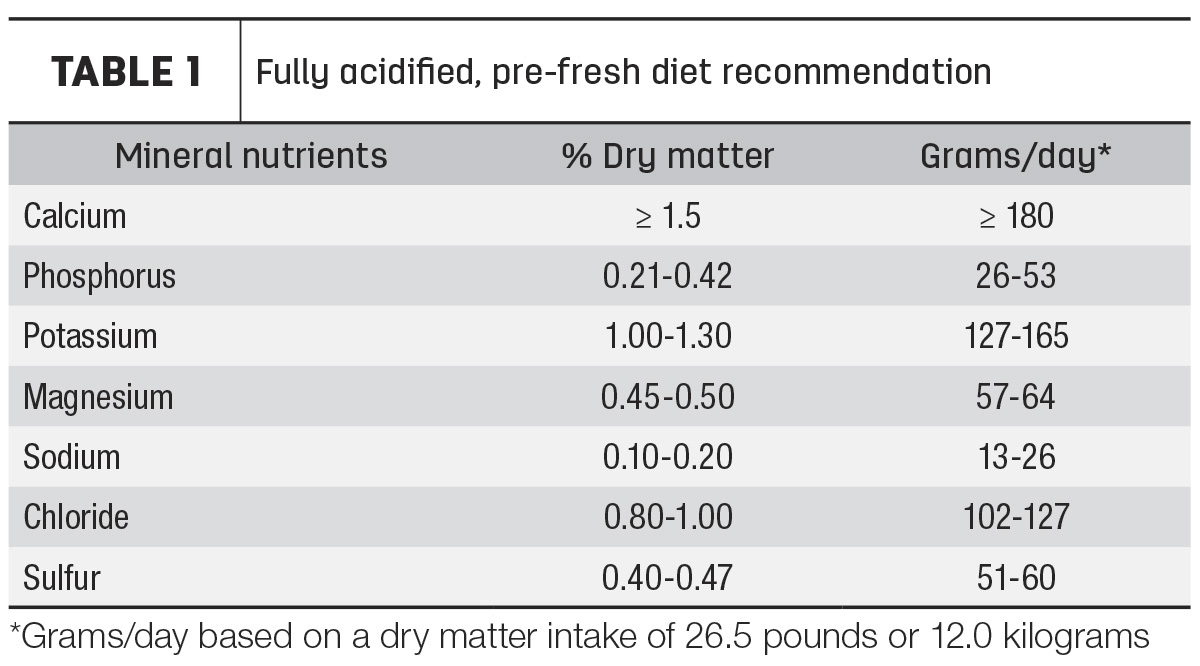For many years, the expectations for high milk production along with excellent herd health and reproductive performance were considered at odds with each other. It was believed you should not and could not expect to achieve high milk yields without compromising herd health and reproductive performance.
As our knowledge has grown of the metabolic and physiological challenges transition cows experience, coupled with a greater understanding of the importance of proper feeding and management for the success of these cows, we now have strategies which help cows meet expectations for high milk yield, herd health and reproductive performance. All three are attainable and should be expected goals.
One of the most significant challenges preventing the achievement of these goals is hypocalcemia (low blood calcium concentrations). Because the calcium requirement for milk synthesis is high, and the period of transition from dry to high milk production is short, the cow may experience a transient period of hypocalcemia. While this is normal, and likely needed, there are strategies available to help reduce the impacts of hypocalcemia on cow health and productivity. The best strategy is to reduce the duration of hypocalcemia by feeding of an acidogenic diet.
This article will review the principal effects of feeding an acidogenic diet and how the effects positively change calcium metabolism in the transition dairy cow to meet the high requirement for milk calcium in early lactation. This prepartum feeding strategy allows the cow to express its full genetic potential for milk yield, health and reproductive performance.
Acidogenic diets change calcium metabolism
Feeding an acidogenic diet using supplemental chlorides and sulfates to reduce the dietary cation-anion difference (DCAD) lowers blood and urine pH. When a negative-DCAD diet is fed, there is a greater balance of negatively charged chloride and sulfur ions compared to positively charged potassium and sodium ions, and more of these negatively charged ions are absorbed from the digestive tract into the blood.
Feeding a negative-DCAD diet results in compensated metabolic acidosis, in which urine pH is significantly reduced while blood pH is maintained in a safe range. It is important to note metabolic acidosis brought about by feeding a negative-DCAD diet does not cause ruminal acidosis.
Low-serum calcium concentrations at calving stimulate the secretion of parathyroid hormone (PTH), which increases calcium release from the bone and vitamin D activation in the kidney (which, in turn, improves calcium absorption in the digestive tract). Feeding a negative-DCAD diet reduces blood pH slightly, which improves the responsiveness of the target tissues to PTH, increasing calcium release from bone and vitamin D activation in the kidney.
When urine pH is reduced, calcium excretion through urine increases. Greater urinary calcium excretion can improve calcium status after calving by increasing calcium flux. Calcium flux is the movement of calcium into and out of the blood of the cow. When urine pH is reduced, and urinary calcium excretion is increased, more calcium exits and enters the cow’s blood; calcium flux is increased.
Calcium excreted in the urine when an acidogenic diet is fed becomes immediately available to meet the sudden increase in calcium demand when colostrum production begins at calving, helping overcome the calcium deficit in fresh cows.
Partially acidified versus fully acidified pre-fresh diets
A partially acidified diet is an acidogenic diet that reduces urine pH between 6.0 and 7.0. Typically, such diets contain DCAD of 0 to -10 milliequivalent (mEq) per 100 grams of dry matter (DM). This feeding strategy is effective at reducing clinical hypocalcemia and may lower the prevalence of subclinical hypocalcemia. Although the response to PTH is likely improved, calcium flux is not greatly increased due to the relatively small reduction in urine pH. Nonetheless, fresh cow intake and milk yield can be improved when a partially acidified prepartum diet is fed compared to a non-acidogenic diet.
A fully acidified diet is an acidogenic diet that maintains urine pH between 5.5 and 6.0, often using diets with a DCAD of -10 to -15 mEq per 100 grams of DM. These diets significantly reduce the prevalence of hypocalcemia by improving the response to PTH and sharply increasing calcium flux due to the significant reductions in urine pH.
A fully acidified pre-fresh diet provides the maximum benefits in fresh cow performance, with higher intakes and greater milk production by fresh cows compared to cows fed non-acidogenic diets and partially acidified diets. Fully acidified pre-fresh diets are safe to feed, with no negative impacts on fresh cow metabolic profiles and no negative effects on calf acid-base status or overall health.
The response to fully acidified pre-fresh diets may be enhanced by feeding more calcium. Recent research showed greater calcium flux in cows fed fully acidified pre-fresh diets, with 2 percent calcium compared to 0.4 percent calcium. Feeding higher amounts of calcium may increase passive absorption of calcium at the intestine to supply more calcium to the exchangeable calcium pool. Optimum performance of cows fed a fully acidified pre-fresh diet is achieved when all dietary minerals are considered. Our recommendations for mineral concentrations and daily intake when a fully acidified, pre-fresh diet is used are presented in Table 1.

Ken Zanzalari earned his B.S. in Dairy Husbandry from Delaware Valley College and an M.S. and Ph.D. in animal science from the University of Tennessee. Zanzalari is an ARPAS board-certified nutritionist with Phibro Animal Health Corporation specializing in transition cow management and nutrition.








